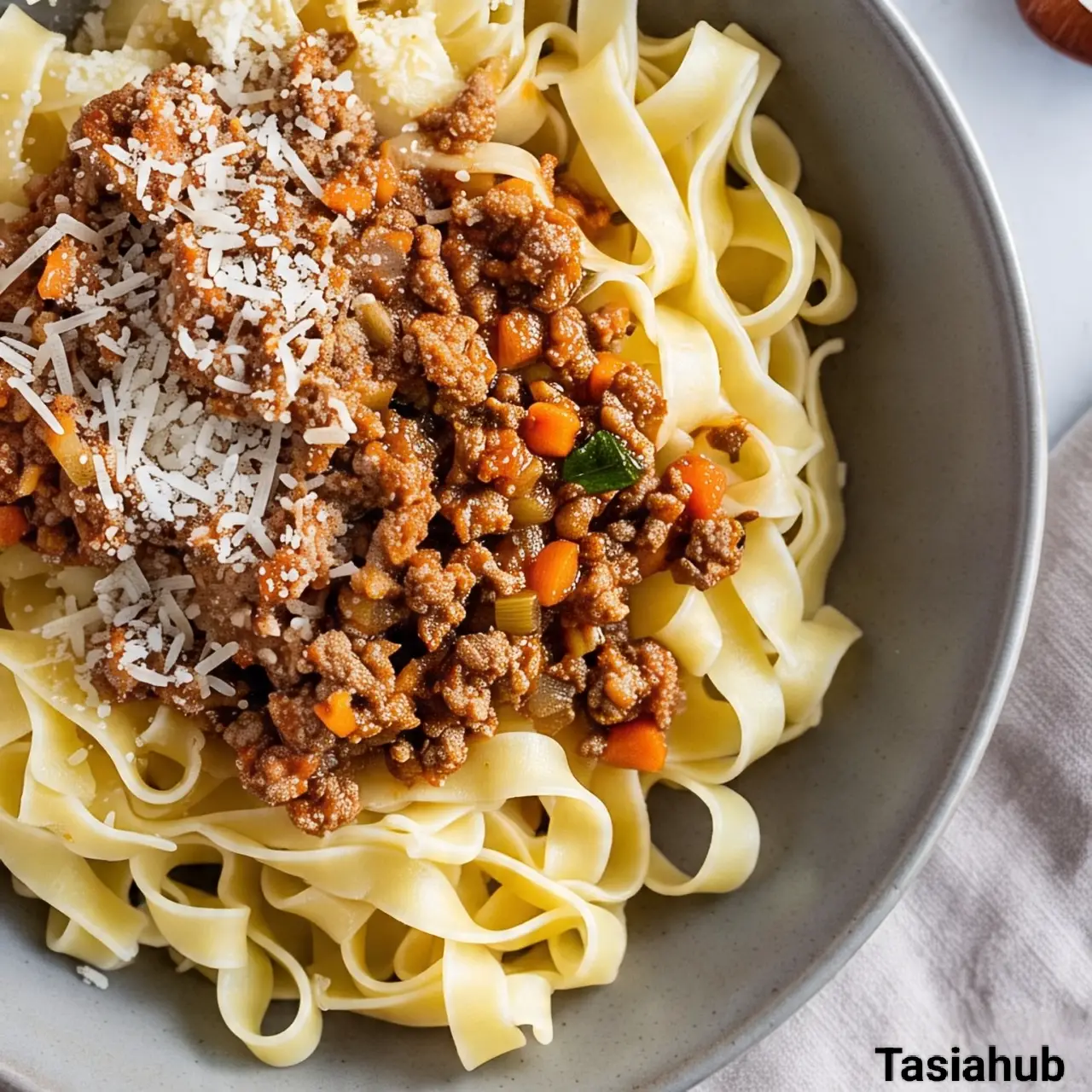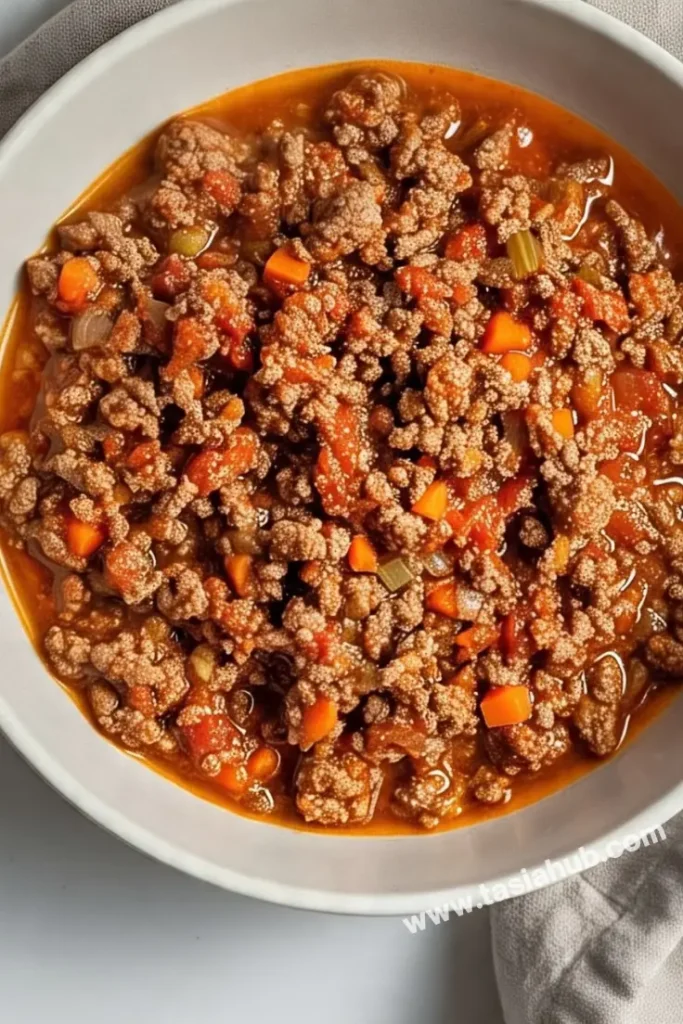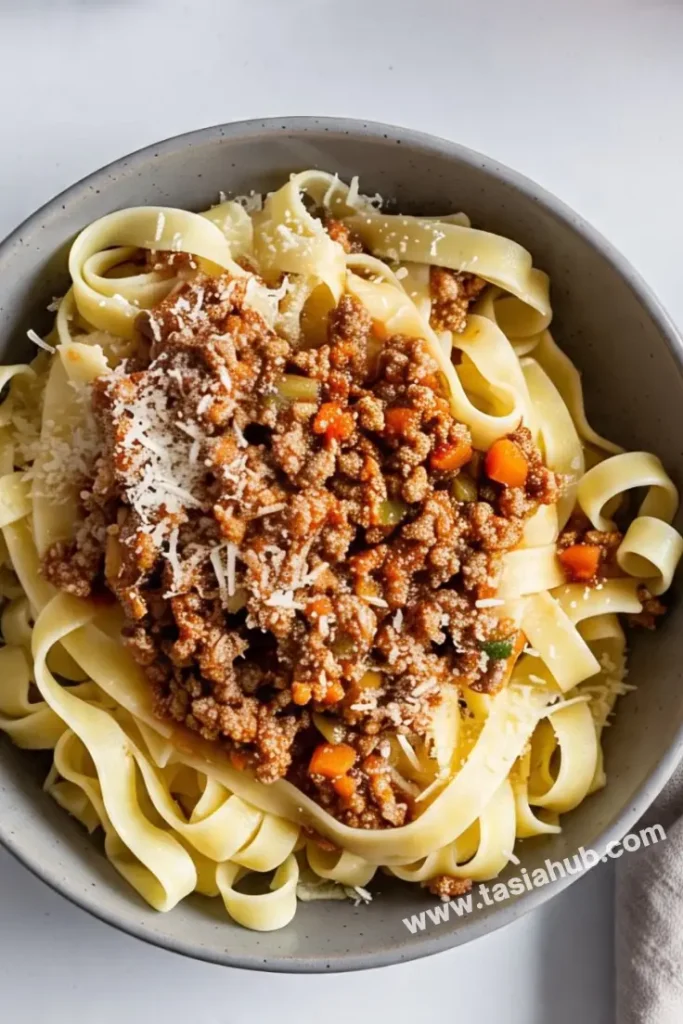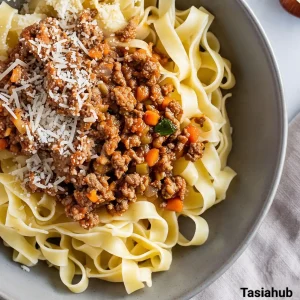The Best Bolognese Sauce Recipe

There’s something about a rich, savory bolognese sauce that just makes everything feel right. It’s the kind of meal that brings comfort, warmth, and a little bit of joy to the table. Imagine stirring a pot of fragrant tomatoes, fresh herbs, and slow-cooked meat, the aroma filling your kitchen and making you feel like you’re in a cozy Italian trattoria. The beauty of bolognese sauce is that it’s a perfect balance of flavors—savory, slightly sweet, with a deep umami kick from the slow-simmered meat. Every bite feels like a hug in a bowl.
What I love about this bolognese sauce is how versatile it is. Sure, it’s perfect over a bowl of pasta, but it’s also fantastic layered in a lasagna or even served with roasted vegetables for a more wholesome meal. The key to making it so special lies in the slow-cooking process.
When you take the time to let the ingredients meld together, magic happens. The flavors deepen, and the sauce becomes a beautiful, velvety masterpiece. Trust me, once you try making bolognese at home, you’ll never want to go back to store-bought versions again.
And, don’t worry—it’s not as complicated as it sounds! Sure, there are a few ingredients to chop and a bit of patience required, but it’s totally worth the effort. Plus, you can make a big batch and enjoy it for days, or freeze some for later when you’re craving a homemade meal without all the work. So grab your apron and let’s make a pot of bolognese sauce.
Why You’ll Love It
- Rich, Savory Flavor: The combination of ground beef, pork, and slow-simmered tomatoes creates a depth of flavor that’s hard to beat. It’s savory, a bit sweet, and oh-so-satisfying.
- Versatile: Bolognese sauce isn’t just for pasta. You can use it in lasagna, on top of roasted vegetables, or even as a hearty topping for baked potatoes.
- Easy to Make in Big Batches: It’s the perfect sauce to make in large quantities. You can enjoy it for days or freeze portions for a quick homemade meal whenever you need it.
- Perfect Comfort Food: There’s something about the slow-cooked flavors that makes bolognese feel like a warm hug. It’s the ultimate comfort food for any time of year.
- Impressive but Simple: While this recipe might sound like something you’d get at a fancy Italian restaurant, it’s surprisingly easy to make at home. You’ll impress your family and friends without all the fuss.
Ingredient List
For the Base:
- 1 tablespoon olive oil
- 1 medium onion, finely chopped
- 1 medium carrot, finely chopped
- 2 celery stalks, finely chopped
- 3 cloves garlic, minced
For the Meat:
- 1/2 lb ground beef
- 1/2 lb ground pork
For the Sauce:
- 1 cup red wine (preferably dry)
- 1 can (28 oz) whole tomatoes, crushed
- 1/2 cup whole milk (or heavy cream for a richer sauce)
- 2 fresh bay leaves
- 1 teaspoon dried thyme or a few sprigs of fresh thyme
- 1/4 cup fresh basil, chopped (optional)
- Salt and pepper, to taste
Ingredient Notes
- Olive Oil: I always use extra virgin olive oil for a smoother, richer flavor.
- Meat Combo: The mix of beef and pork gives the sauce a delicious balance of flavor and richness. If you can’t find both, lean ground beef works just fine.
- Red Wine: Don’t skip the wine! It adds a beautiful depth to the sauce. If you don’t drink wine, you can substitute with a splash of balsamic vinegar, but wine is definitely the best choice.
- Milk: Whole milk is ideal here as it creates a creamy texture without being too heavy. If you want a richer, more indulgent sauce, feel free to use cream.
- Tomatoes: Use whole, peeled tomatoes for the best flavor—crushing them yourself ensures a more natural texture. San Marzano tomatoes are the gold standard if you can find them!
Kitchen Equipment Needed
- Large Pot or Dutch Oven: For simmering the sauce and evenly cooking all the ingredients. I love using my Le Creuset Dutch oven—it distributes heat so well and keeps the sauce at the perfect simmer.
- Wooden Spoon or Spatula: To stir the sauce gently and scrape up any flavorful bits from the bottom of the pot. A good wooden spoon is key here to avoid scratching your cookware.
- Sharp Knife: For chopping the onions, carrots, celery, and garlic. A sharp chef’s knife makes all the chopping tasks much easier and quicker.
- Can Opener: For opening the canned tomatoes. A smooth-opening can opener like the OXO Good Grips one makes this task hassle-free.
- Measuring Cups & Spoons: To get accurate measurements for the wine, milk, and seasonings. It makes cooking a lot more streamlined and helps you avoid over- or under-seasoning.
- Wooden or Silicone Spoon Rest: To keep your countertop clean while stirring. A spoon rest is a small detail that makes cooking a little more organized!
Instructions
Step 1: Prepare the Veggies
- Heat 1 tablespoon of olive oil in a large pot or Dutch oven over medium heat.
- Add the finely chopped onion, carrot, and celery to the pot.
- Cook for 8–10 minutes, stirring occasionally, until the vegetables have softened and the onions are translucent.
- Pro Tip: Don’t rush this step—let the veggies cook slowly to bring out their natural sweetness and depth of flavor.
Step 2: Add the Garlic
- Add the minced garlic to the pot with the softened veggies.
- Stir for about 1 minute, just until fragrant—be careful not to burn the garlic.
- Pro Tip: If the garlic starts to brown too quickly, lower the heat. Burnt garlic can make the sauce taste bitter.
Step 3: Brown the Meat
- Add the ground beef and ground pork to the pot.
- Break up the meat with a wooden spoon, making sure it’s fully browned and no longer pink (about 8–10 minutes).
- Stir occasionally, ensuring the meat gets evenly browned for the best flavor.
- Pro Tip: Make sure the meat is well-browned before moving on. The caramelization adds a lot of flavor to the sauce!
Step 4: Deglaze the Pot with Wine
- Pour in 1 cup of red wine.
- Stir the meat and vegetables as the wine bubbles up, scraping the bottom of the pot to release any browned bits (they’re packed with flavor!).
- Let the wine simmer for 3–4 minutes until it’s mostly reduced.
- Pro Tip: Let the wine reduce to concentrate the flavor. If you skip this step, you might miss out on that deep, rich taste.
Step 5: Add the Tomatoes and Dairy
- Add the 28-oz can of crushed tomatoes to the pot, including the juice.
- Pour in the 1/2 cup of milk (or cream if you prefer a richer sauce).
- Stir to combine everything evenly.
- Add the fresh thyme, bay leaves, and chopped basil (if using).
- Season with salt and pepper to taste.
- Pro Tip: Stir everything well to make sure the milk blends in smoothly with the tomatoes. The milk will soften the acidity of the tomatoes and create a velvety texture.
Step 6: Simmer the Sauce
- Bring the sauce to a gentle simmer over low heat.
- Cover the pot partially with a lid, leaving a small gap for steam to escape.
- Let the sauce simmer for 1.5 to 2 hours, stirring occasionally.
- Taste and adjust seasoning if needed.
- Pro Tip: The longer you let the sauce simmer, the more flavorful it becomes. If you have time, let it cook even longer for an even richer taste.
Step 7: Serve
- Remove the bay leaves and thyme sprigs (if using fresh thyme).
- Serve the bolognese sauce over your favorite pasta, such as spaghetti, tagliatelle, or pappardelle.
- Garnish with freshly grated Parmesan cheese, if desired.
- Pro Tip: For extra richness, drizzle a little more olive oil over the top before serving. It adds a glossy finish and a subtle fruity flavor.
Enjoy your homemade bolognese sauce!

Tips and Tricks for Success
- Slow Cooking is Key: Don’t rush the simmering process. The longer you let the sauce cook, the deeper and more flavorful it becomes. If possible, let it simmer for 3–4 hours for the best results.
- Use Fresh Herbs: Fresh herbs, like basil and thyme, add a lovely fragrance to the sauce. If you can, opt for fresh over dried.
- Brown the Meat Well: Browning the meat thoroughly is essential. It creates those delicious caramelized bits that give the sauce its richness and depth.
- Don’t Skip the Milk or Cream: This is the secret to a silky, smooth bolognese. It balances the acidity of the tomatoes and gives the sauce its velvety texture.
- Taste as You Go: Always taste your sauce before serving and adjust the seasoning. A pinch of salt or a dash of pepper can go a long way in enhancing the flavor.
- Make it Ahead: Bolognese sauce tastes even better the next day! Make a big batch and store leftovers in the fridge for up to 3 days, or freeze for later use.
Ingredient Substitutions and Variations
- Ground Meat: Swap out the ground beef and pork for other meats like ground turkey or chicken for a lighter version. For a richer sauce, you could even add some pancetta or Italian sausage.
- Red Wine: If you don’t drink alcohol, substitute the wine with a splash of balsamic vinegar or vegetable broth. It won’t be exactly the same, but it still adds a nice depth of flavor.
- Milk: Use heavy cream for a richer, more indulgent sauce. If you prefer a dairy-free version, you can use coconut milk or a dairy-free cream alternative.
- Tomatoes: If you can’t find canned whole tomatoes, crushed tomatoes, or passata (strained tomatoes) will work as a substitute. Just keep an eye on the consistency while simmering.
- Herbs: Dried versions work well if you don’t have fresh thyme or basil. Or try adding a touch of oregano for a more Mediterranean flavor.
- Pasta: While this sauce is traditionally served with wide, flat pasta like tagliatelle or pappardelle, you can use any pasta shape you like. It’s especially delicious over spaghetti, rigatoni, or even gnocchi.
Serving Suggestions
- Classic Pasta: Serve your bolognese sauce over a bed of wide pasta like tagliatelle or pappardelle for the classic Italian experience. The sauce clings perfectly to these ribbons of pasta.
- Garlic Bread and Salad: I love serving this pasta with garlic bread and a crisp green salad—it balances the richness perfectly!
- Layered in Lasagna: Use this bolognese as the meat layer in a hearty lasagna, layering it with creamy ricotta, mozzarella, and a bit of béchamel sauce for an indulgent dish.
- Roasted Vegetables: For a lighter meal, serve the bolognese sauce on top of roasted vegetables like zucchini, eggplant, or even cauliflower rice for a comforting yet healthy twist.
- Over Polenta: Spoon the bolognese over creamy polenta for a rich and hearty meal that feels just as cozy as pasta but with a different texture.

Storage and Reheating Instructions
- Refrigerating: Store leftovers in an airtight container in the fridge for up to 3 days. The flavors continue to develop, so it’s even better the next day!
- Freezing: You can freeze the bolognese sauce for up to 3 months. Just let it cool completely before transferring it to a freezer-safe container. When ready to use, thaw overnight in the fridge and reheat.
- Reheating: To reheat, simply warm the sauce on the stove over low heat, stirring occasionally until it’s heated through. If the sauce has thickened too much in the fridge, add a splash of water, wine, or broth to loosen it up.
- Microwave: If you’re in a rush, you can microwave individual portions on a microwave-safe plate for 1-2 minutes, stirring halfway through. Just be sure to cover it to prevent splattering.
Frequently Asked Questions
Can I make this sauce ahead of time?
Yes, absolutely! In fact, bolognese tastes even better the next day after the flavors have had time to meld together. You can make it up to 3 days ahead and store it in the fridge. It’s perfect for meal prep!
Can I freeze the bolognese sauce?
Yes, this sauce freezes beautifully! Let it cool completely, then store it in an airtight container or freezer bag. It’ll stay good for up to 3 months. Just thaw it in the fridge overnight before reheating.
Can I use ground turkey or chicken instead of beef and pork?
Definitely! Ground turkey or chicken can be used for a lighter version of bolognese. It will still be delicious, though it will have a slightly different flavor profile.
What kind of pasta should I use?
I love pairing bolognese with wide, flat pasta like tagliatelle or pappardelle, but spaghetti, rigatoni, or even gnocchi work wonderfully as well. The key is to choose a pasta that can hold up to the rich sauce.
What’s the best way to store leftovers?
Store leftovers in an airtight container in the fridge for up to 3 days. You can also freeze them for up to 3 months. Just make sure to cool the sauce completely before storing it!
Can I make this recipe in a slow cooker?
Yes! Brown the meat and sauté the vegetables first, then transfer everything to the slow cooker with the remaining ingredients. Cook on low for 6–8 hours for a perfectly rich and tender sauce.
Did you try this recipe? Let me know in the comments how it turned out!
Don’t forget to share your photos on Instagram and tag me (@tasiahub_) or use the hashtag (#tasiahub). I’d love to see your creations!

The Best Bolognese Sauce Recipe
Equipment
- Large Pot or Dutch Oven
- Wooden spoon or spatula
- Sharp Knife
- Can Opener
- Measuring Cups & Spoons
- Wooden or Silicone Spoon Rest
Ingredients
For the Base:
- 1 tablespoon olive oil
- 1 medium onion finely chopped
- 1 medium carrot finely chopped
- 2 celery stalks finely chopped
- 3 cloves garlic minced
For the Meat:
- 1/2 lb ground beef
- 1/2 lb ground pork
For the Sauce:
- 1 cup red wine preferably dry
- 1 can 28 oz whole tomatoes, crushed
- 1/2 cup whole milk or heavy cream for a richer sauce
- 2 fresh bay leaves
- 1 teaspoon dried thyme or a few sprigs of fresh thyme
- 1/4 cup fresh basil chopped (optional)
- Salt and pepper to taste
Instructions
Step 1: Prepare the Veggies
- Heat 1 tablespoon of olive oil in a large pot or Dutch oven over medium heat.
- Add the finely chopped onion, carrot, and celery to the pot.
- Cook for 8–10 minutes, stirring occasionally, until the vegetables have softened and the onions are translucent.
- Pro Tip: Don’t rush this step—let the veggies cook slowly to bring out their natural sweetness and depth of flavor.
Step 2: Add the Garlic
- Add the minced garlic to the pot with the softened veggies.
- Stir for about 1 minute, just until fragrant—be careful not to burn the garlic.
- Pro Tip: If the garlic starts to brown too quickly, lower the heat. Burnt garlic can make the sauce taste bitter.
Step 3: Brown the Meat
- Add the ground beef and ground pork to the pot.
- Break up the meat with a wooden spoon, making sure it’s fully browned and no longer pink (about 8–10 minutes).
- Stir occasionally, ensuring the meat gets evenly browned for the best flavor.
- Pro Tip: Make sure the meat is well-browned before moving on. The caramelization adds a lot of flavor to the sauce!
Step 4: Deglaze the Pot with Wine
- Pour in 1 cup of red wine.
- Stir the meat and vegetables as the wine bubbles up, scraping the bottom of the pot to release any browned bits (they’re packed with flavor!).
- Let the wine simmer for 3–4 minutes until it’s mostly reduced.
- Pro Tip: Let the wine reduce to concentrate the flavor. If you skip this step, you might miss out on that deep, rich taste.
Step 5: Add the Tomatoes and Dairy
- Add the 28 oz can of crushed tomatoes to the pot, including the juice.
- Pour in the 1/2 cup of milk (or cream if you prefer a richer sauce).
- Stir to combine everything evenly.
- Add the fresh thyme, bay leaves, and chopped basil (if using).
- Season with salt and pepper to taste.
- Pro Tip: Stir everything well to make sure the milk blends in smoothly with the tomatoes. The milk will soften the acidity of the tomatoes and create a velvety texture.
Step 6: Simmer the Sauce
- Bring the sauce to a gentle simmer over low heat.
- Cover the pot partially with a lid, leaving a small gap for steam to escape.
- Let the sauce simmer for 1.5 to 2 hours, stirring occasionally.
- Taste and adjust seasoning if needed.
- Pro Tip: The longer you let the sauce simmer, the more flavorful it becomes. If you have time, let it cook even longer for an even richer taste.
Step 7: Serve
- Remove the bay leaves and thyme sprigs (if using fresh thyme).
- Serve the bolognese sauce over your favorite pasta, such as spaghetti, tagliatelle, or pappardelle.
- Garnish with freshly grated Parmesan cheese, if desired.
- Pro Tip: For extra richness, drizzle a little more olive oil over the top before serving. It adds a glossy finish and a subtle fruity flavor.
Notes
Estimated Nutritional Value (Per Serving):
- Calories: ~420 kcal
- Protein: 22–25g
- Fat: 25g
- Carbohydrates: 12g
- Fiber: 2–3g
- Sugar: 5–6g
- Sodium: ~600–700mg